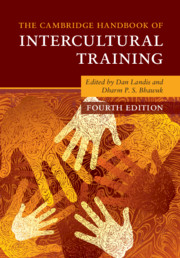Book contents
- The Cambridge Handbook of Intercultural Training
- Reviews
- The Cambridge Handbook of Intercultural Training
- Copyright page
- Dedication
- Frontispiece
- Contents
- Figures
- Tables
- Editors and Contributors
- Foreword
- Preface
- 1 Introduction and Theoretical Framework
- Part I Theoretical Foundations of Intercultural Training
- Part II Practice of Intercultural Training
- Part III Indigenous Psychology and Intercultural Training
- Part IV New Interdisciplinary Approaches to Intercultural Training
- 20 Cultural Neuroscience Basis of Intercultural Training and Education
- 21 Perceptual Representation
- 22 Emotional Contagion, Intimate Intercultural Relationships, and Intercultural Training
- 23 Dialogue and Culture
- 24 Optimizing Globalization through “Intelligent Swarming”
- Part V Summing Up
- Index
- References
20 - Cultural Neuroscience Basis of Intercultural Training and Education
from Part IV - New Interdisciplinary Approaches to Intercultural Training
Published online by Cambridge University Press: 18 September 2020
- The Cambridge Handbook of Intercultural Training
- Reviews
- The Cambridge Handbook of Intercultural Training
- Copyright page
- Dedication
- Frontispiece
- Contents
- Figures
- Tables
- Editors and Contributors
- Foreword
- Preface
- 1 Introduction and Theoretical Framework
- Part I Theoretical Foundations of Intercultural Training
- Part II Practice of Intercultural Training
- Part III Indigenous Psychology and Intercultural Training
- Part IV New Interdisciplinary Approaches to Intercultural Training
- 20 Cultural Neuroscience Basis of Intercultural Training and Education
- 21 Perceptual Representation
- 22 Emotional Contagion, Intimate Intercultural Relationships, and Intercultural Training
- 23 Dialogue and Culture
- 24 Optimizing Globalization through “Intelligent Swarming”
- Part V Summing Up
- Index
- References
Summary
Economic globalization brings increasing demands and opportunities for intercultural training and education that produce novel consequences on people’s mind, behavior, and life quality. Why and how do intercultural training and education change mind and behavior? This chapter aims to address these issues from a cultural neuroscience perspective. By reviewing recent brain imaging findings of East Asian/Western cultural differences in neural underpinnings of cognition and emotion, we discuss the neural basis for understanding intercultural training and education by examining changes of functional brain activity underlying cognitive and affective processes. We propose a theoretical analysis of intercultural training and education based on the culture-behavior-brain loop model of human development. Future issues related to intercultural training and education are discussed.
- Type
- Chapter
- Information
- The Cambridge Handbook of Intercultural Training , pp. 601 - 616Publisher: Cambridge University PressPrint publication year: 2020
References
- 1
- Cited by



